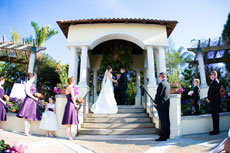A simple civil ceremony is all you actually need to be legally married. Religious ceremonies are a bit more complicated. Find out what you need to know.
By: Rachel Griffiths
|
A simple civil ceremony is all you actually need to be legally married. Religious ceremonies are a bit more complicated. If that’s your choice, you must clear all your plans with your clergyperson, as some houses of worship have strict rules for wedding services.
The Christian Ceremony
- The processional marks the beginning of the ceremony. The groomsmen enter first, followed by the bridesmaids, the maid of honor, the ring bearer, the flower girl and the bride on her father’s arm. The groom waits at the altar with his best man and the celebrant.
- In the presentation, the bride’s father escorts her to the groom.
- A blessing follows.
- The officiant asks the bride and groom that famous question, “Do you take…?”
- The couple exchanges vows, followed by a benediction recited by the officiant.
- The couple exchanges rings.
- The officiant announces to the community that the couple is wed and grants the groom permission to kiss his wife.
- During the recessional, the couple exits the church, followed by the wedding party.
The Jewish Ceremony
- The signing of the ketubah: This ornately decorated contract spells out the rights of the bride and starts the proceedings. In an Orthodox wedding, the signing is followed by the bedeken, in which the groom places a veil on his bride.
- The rabbi leads a procession of the cantor, the groomsmen, the best man, the groom and his parents, the bridesmaids, the maid of honor and the bride and her parents to the chuppah, a canopy symbolizing home and sacred space. The bride circles the groom seven times; in some synagogues, the groom may also circle the bride.
- The bride and groom drink wine from a cup as a blessing is given.
- The couple exchanges rings.
- The rabbi reads the ketubah.
- The rabbi recites the sheva berachot, or “seven blessings.”
- The groom crushes a wineglass beneath his foot, symbolizing the destruction of the Temple in Jerusalem and the fragility of life and human relationships.
- The couple observes the yichud (which means “seclusion”), where they spend a short time alone, savoring their newlywed status.
The Civil Ceremony
(conducted by a judge, county or court clerk or justice of the peace)
- In the processional, the couple enters with their wedding party.
- The couple outlines the commitment they’re making to each other and exchange rings.
- The celebrant pronounces the couple husband and wife.
- During the recessional, the couple and their attendants make their exit.
License Lowdown
Whether you marry in a church or a town hall, on a mountaintop or on a beach, you need a marriage license. License requirements vary from state to state and even from county to county (go to findlaw.com for state-by-state information). Some require couples to apply in person and pay a cash fee (anywhere from $25 to $100); you’ll also be asked to bring along identification, like a passport or Social Security card. Once you have the license, it must be signed by the two of you, your officiant and possibly witnesses. Your officiant must mail the license to the proper state authorities (you’ll receive a certified marriage certificate in the mail within weeks), but in the eyes of the government you are husband and wife from the moment everyone signs the license.
For more information, check out our Marriage License Guide.



